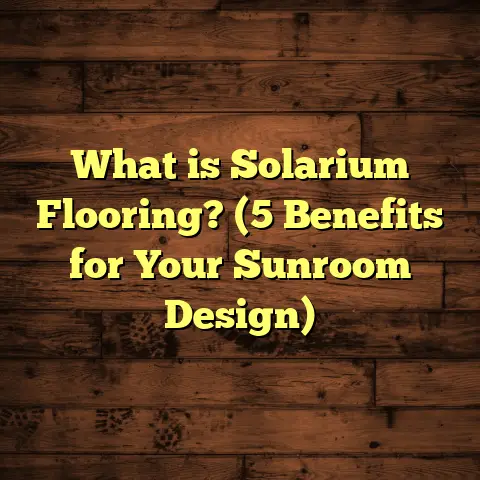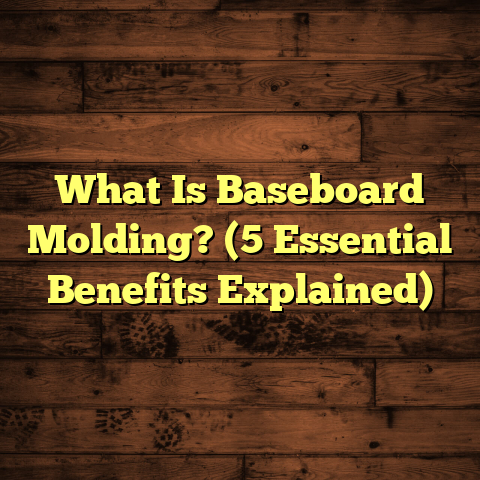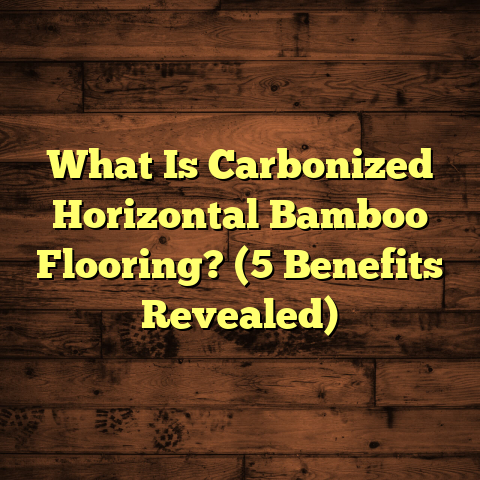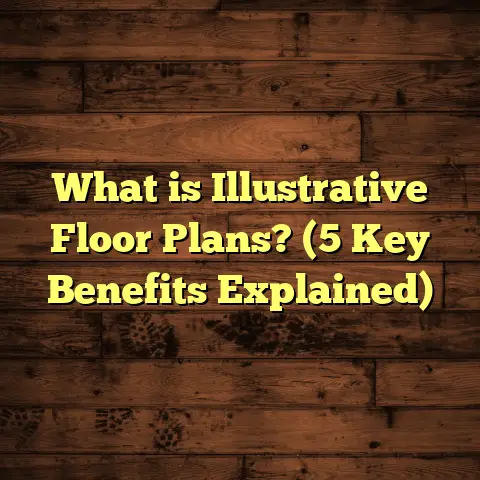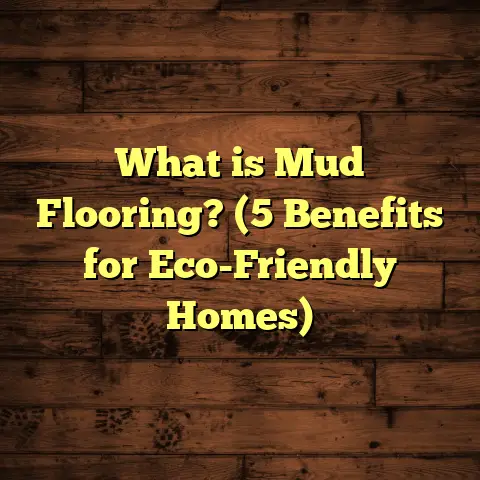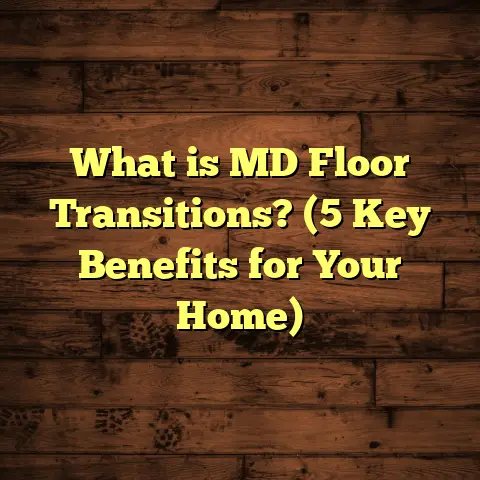What is Fake Wood Flooring? (5 Types You Need to Know!)
Embracing Eco-Tech in Flooring: A Personal Take on Fake Wood Flooring
Sustainability has become a huge part of how I approach every flooring project these days. I’m always looking for ways to combine eco-friendly technology with durability and style. One of the biggest game-changers in flooring materials for me has been fake wood flooring. It’s an innovation that’s helping reduce deforestation while still giving homeowners the warmth and beauty of wood floors.
I remember when I started in this business nearly 15 years ago, real hardwood was king. Everyone wanted solid oak or maple floors, but it often came with a high price tag and environmental concerns. Plus, hardwood floors can be tricky to maintain, especially in humid or high-traffic homes.
Fake wood flooring has evolved incredibly since then. Today, it offers some of the best qualities of wood without many of the downsides. Whether you’re after affordability, resistance to moisture, or eco-conscious choices, there’s likely a fake wood option that fits your needs.
In this article, I want to share what I’ve learned from installing thousands of square feet of different fake wood floors across various climates and conditions. I’ll also dive into some detailed facts and figures to help you understand what makes each type unique.
What Is Fake Wood Flooring?
Fake wood flooring is any flooring product designed to look like natural hardwood but made from alternative materials. These alternatives replicate the look and feel of wood through advanced manufacturing techniques without using solid planks cut from trees.
The idea is simple: deliver the aesthetic appeal of hardwood at a lower cost, with improved durability and easier upkeep. This makes fake wood flooring popular for families with kids, pet owners, and people living in humid or high-traffic environments.
Here’s a quick breakdown of what sets fake wood apart from real wood:
- Material: Instead of solid wood planks, fake wood floors use composites like fiberboard, vinyl, bamboo grass, or ceramic.
- Cost: Generally more affordable; you can save 30-70% compared to solid hardwood.
- Installation: Many fake wood floors feature click-lock systems for DIY installation.
- Maintenance: Resistant to scratches, stains, and water damage; no sanding or refinishing required.
- Environmental Impact: Some products use recycled materials or rapid-growth plants like bamboo.
Why I Got Interested in Fake Wood Flooring
When I first started as a flooring contractor, I was skeptical about fake wood products. They seemed cheap and plastic-looking compared to the rich texture of real hardwood. But over time, I realized the industry was changing fast.
A turning point for me was a project about seven years ago. A family in Houston wanted new floors but had two young kids and a dog. Their old hardwood was scratched and water-damaged from spills and muddy paws. I suggested trying luxury vinyl plank (LVP) flooring.
The result blew me away. The floor looked so close to real wood that even their neighbors didn’t believe it wasn’t hardwood. Plus, it held up perfectly against stains and moisture. That project taught me there’s real value in these alternatives.
Five Types of Fake Wood Flooring You Should Know About
There are many options when it comes to fake wood flooring. Each has its own benefits depending on your budget, lifestyle, and design preferences. Here are the five main types I’ve worked with extensively:
1. Laminate Flooring: Affordable and Durable
Laminate flooring is one of the most popular fake wood options because it delivers decent looks at a low price. It consists of several layers:
- A core made from high-density fiberboard (HDF)
- A photographic layer that replicates wood grain
- A clear wear layer that protects against scratches and stains
Why Laminate Works Well
Laminate is great for people who want the wood look but don’t want to spend a fortune or worry about maintenance. I’ve installed laminate in family rooms, basements, and rental properties where heavy traffic is expected.
Here’s what you should know about laminate costs and specs:
- Average material cost: $2 – $4 per sq ft
- Installation cost: $1 – $3 per sq ft (DIY is common due to click-lock design)
- Thickness: 6mm to 12mm (thicker planks are more durable)
- Lifespan: Typically 10 to 20 years with proper care
One thing clients love is how laminate resists dents and scratches better than solid hardwood. Once, a client with three active kids chose laminate for their playroom. After two years, the floor still looked great despite all the spills and dropped toys.
Downsides to Consider
Laminate is not waterproof — standing water can cause the fiberboard core to swell or warp. So it’s best avoided in bathrooms or laundry rooms unless you choose specialized water-resistant laminates.
Also, it doesn’t have the same warmth underfoot as real wood or engineered wood floors.
2. Luxury Vinyl Plank (LVP): Waterproof and Realistic
Luxury vinyl plank flooring has surged in popularity because it combines beauty with practical benefits like waterproofing. LVP is composed of several layers:
- A rigid core (often made from stone plastic composite or SPC)
- A photographic film layer mimicking wood grain
- A vinyl wear layer protecting against scratches and stains
What sets LVP apart is its ability to withstand moisture without damage — perfect for kitchens, bathrooms, basements, or even outdoor covered patios.
My Experience With LVP
I installed LVP in a beachfront condo in Florida where humidity levels were consistently high. The client had struggled with hardwood floors warping every rainy season before switching to LVP.
After three years, the floor looks as good as new. The waterproof nature saved them thousands in repairs compared to previous hardwood installations.
Cost Breakdown
- Material cost: $3 – $7 per sq ft
- Installation cost: $1 – $4 per sq ft
- Thickness: Mostly 4mm to 8mm
- Lifespan: 15 to 25 years with normal wear
LVP also tends to have better sound absorption than laminate or tile, which makes homes quieter.
3. Engineered Wood Flooring: Real Wood Veneer on Composite Core
Engineered wood combines the best of both worlds — a thin layer of real hardwood on top with stable plywood or fiberboard layers beneath.
This structure solves many problems associated with solid hardwood floors: it resists warping from moisture and temperature swings better while still providing authentic wood grain textures.
Why I Recommend Engineered Wood
For clients wanting genuine hardwood but living in climates with humidity swings — like Seattle or New Orleans — engineered wood is a smart choice.
A homeowner friend installed engineered oak in their kitchen. After two years of summer humidity spikes and winter dryness, their floor remained flat and smooth with no gaps or cupping.
Cost & Installation Info
- Material cost: $4 – $8 per sq ft
- Installation options: Nail-down, glue-down, floating
- Veneer thickness: 1mm to 4mm
- Lifespan: 20+ years with refinishing possible on thicker veneers
Engineered wood can be sanded lightly once or twice if the veneer is thick enough — something you can’t do with laminate or vinyl.
4. Wood-Look Tile: Durable Ceramic or Porcelain Planks
Wood-look tile takes ceramic or porcelain tile and prints realistic wood grain patterns onto it. It’s one of my favorite options for areas needing durability combined with style.
Think entryways where mud and rain bring dirt inside or outdoor patios exposed to weather elements year-round.
Project Highlight
I helped a couple redesign their mudroom using wood-look porcelain tile. They wanted something that looked warm but could handle wet boots and pet paws easily.
The tile they picked was 12×48 inches long planks with matte finish — visually stunning and extremely tough underfoot.
Cost & Specs
- Price range: $5 – $10 per sq ft
- Thickness: 8mm to 12mm
- Installation: Requires skilled labor for grout work
- Maintenance: Easy cleaning; grout needs occasional sealing
Tiles don’t scratch like wood either — ideal if you need longevity without refinishing.
5. Bamboo Flooring: Fast-Growing Natural Alternative
Bamboo is unique because it’s a natural material but not traditional hardwood. It’s a grass that grows quickly (some species ready for harvest after just five years).
Processed into planks that look similar to hardwood floors, bamboo offers a sustainable alternative that’s gaining popularity among eco-conscious homeowners.
Why Bamboo Stands Out
I installed strand-woven bamboo floors for a green building project in Portland. The hardness rating was impressive — harder than many oak species — making it highly durable for busy households.
Plus, bamboo captures carbon dioxide efficiently as it grows, reducing your home’s carbon footprint compared to traditional woods harvested over decades.
Pricing & Installation
- Material cost: $3 – $8 per sq ft
- Installation: Floating floor or nail-down
- Lifespan: Comparable to hardwood if maintained well
One note — avoid low-quality bamboo products that use toxic adhesives during manufacturing. Always check certifications like FSC or FloorScore for safety assurances.
Comparing the Types Side by Side
To help you visualize differences better, here’s a quick comparison chart based on my experience:
| Type | Cost/Sq Ft | Waterproof | Durability | Maintenance | Eco-Friendliness | Installation |
|---|---|---|---|---|---|---|
| Laminate | $2-$4 | No | Moderate | Low | Medium (some recycled) | DIY click-lock |
| Luxury Vinyl Plank | $3-$7 | Yes | High | Very Low | Medium (some recycled) | Click-lock/glue-down |
| Engineered Wood | $4-$8 | Moderate | High | Moderate | Medium (depends on veneer source) | Nail/glue/floating |
| Wood-Look Tile | $5-$10 | Yes | Very High | Low | Low | Professional grout |
| Bamboo | $3-$8 | No | High (strand-woven) | Moderate | High (rapid growth) | Floating/nail-down |
How I Choose Flooring for Different Rooms
Over the years working on dozens of projects, I’ve developed some rules of thumb for picking fake wood flooring by room type:
Living Rooms & Bedrooms
These spaces usually have moderate foot traffic without moisture risks. Laminate or engineered wood works well here depending on budget.
In my own home’s living room, I installed engineered hickory three years ago — it’s warm underfoot and adds value without the worry of scratches I had with previous solid hardwood.
Kitchens & Bathrooms
Moisture resistance is key here. LVP is my go-to recommendation because it handles spills gracefully while maintaining that authentic wood look.
A kitchen renovation client last year loved how easy their LVP floor was to clean after baking sessions left flour dust everywhere.
Basements & Laundry Rooms
Basements often have moisture problems so waterproof flooring like LVP or wood-look tile are best bets.
I worked on a Chicago basement finishing project where we used LVP due to its waterproof core; the floor stayed intact through seasonal flooding issues common in that area.
Outdoor Covered Areas
Wood-look porcelain tile is unbeatable for outdoor patios or covered porches because it handles weather without warping or fading.
Installation Tips From My Toolbox
I’ve installed thousands of square feet of fake wood flooring over my career — here are some things I’ve learned that make projects smoother:
- Acclimate materials: Especially engineered wood needs time indoors before installation to adjust humidity.
- Prep subfloor: Ensure subfloor is level and clean; imperfections can cause planks to click or separate.
- Use proper underlayment: This cushions floors and reduces noise.
- Hire pros for tile: Wood-look tile requires grouting skills; DIY attempts often lead to uneven surfaces.
- Plan for expansion gaps: Most fake wood floors expand slightly—leave gaps near walls covered by baseboards.
Maintenance Advice From Me For Longevity
Keeping fake wood floors looking good means regular care but less hassle than real hardwood:
- Sweep or vacuum frequently to avoid grit scratching surfaces.
- Use damp mop with recommended cleaners; avoid excess water on non-waterproof types.
- Place felt pads under furniture legs.
- Clean spills immediately.
In my experience, clients who follow these simple steps extend their floor’s lifespan by years beyond manufacturer estimates.
Environmental Impact: What Does Research Say?
I dug into some studies comparing environmental effects of fake vs real hardwood floors:
- Producing one square meter of laminate emits approximately 13 kg CO₂ equivalent versus around 30 kg CO₂ for solid oak flooring.
- Vinyl plank made with recycled content cuts landfill waste by nearly 40%.
- Bamboo plantations absorb carbon at rates up to five times faster than traditional forests.
These numbers reaffirm what I’ve seen firsthand — choosing alternative materials reduces your home’s carbon footprint without sacrificing beauty or comfort.
Case Study: Transforming a Family Home With LVP Flooring
Last year I worked on a project for a family in Austin who wanted new floors throughout their home including kitchen, living room, and basement playroom.
They were concerned about pets scratching floors and kids spilling drinks constantly.
We chose LVP throughout because it was waterproof and very durable yet looked like warm oak planks they loved.
Results after one year:
- Zero water damage incidents despite frequent spills
- Minimal scratches from dog nails
- Easy cleaning process reduced time spent maintaining floors by half
- Family reported loving how cozy the home felt with the natural-looking planks
This project reinforced how modern fake wood flooring can meet demanding family needs beautifully.
What About Costs? Budgeting Realities From My Experience
Budget always plays a big role in choosing flooring types. Here are average total costs including installation based on recent projects:
| Flooring Type | Material Cost (per sq ft) | Installation Cost (per sq ft) | Total Cost for 500 sq ft Room |
|---|---|---|---|
| Laminate | $2 – $4 | $1 – $3 | $1,500 – $3,500 |
| Luxury Vinyl Plank | $3 – $7 | $1 – $4 | $2,000 – $5,500 |
| Engineered Wood | $4 – $8 | $2 – $5 | $3,000 – $6,500 |
| Wood-Look Tile | $5 – $10 | $4 – $8 | $4,500 – $9,000 |
| Bamboo | $3 – $8 | $2 – $5 | $2,500 – $6,500 |
Prices vary by location — urban areas tend toward higher labor costs; rural areas may have fewer material choices causing price fluctuations as well.
Common Questions I Get Asked About Fake Wood Floors
Q: Can you refinish laminate or vinyl floors?
A: No — these materials cannot be sanded down like hardwoods. If damaged beyond repair, they must be replaced.
Q: Are fake wood floors good for pets?
A: Yes! Vinyl plank especially resists scratches from claws better than most hardwoods or laminates.
Q: Will fake wood flooring fade over time?
A: High-quality products use UV-resistant coatings minimizing fading even in sunny rooms.
Q: How long does installation take?
A: Typically one day per 500 sq ft room for laminate and vinyl; tile takes longer due to grout curing times.
Final Thoughts From My Flooring Journey
Fake wood flooring isn’t just an affordable alternative anymore—it’s become a smart choice combining beauty, practicality, and sustainability.
I encourage people to think beyond just initial costs and consider environmental impact plus long-term durability when deciding between real hardwood and these alternatives.
Over thousands of projects across multiple states—humid Florida to dry Arizona—I’ve seen how choosing the right type transforms homes while respecting budgets and planet health alike.
If you want help figuring out which type fits your lifestyle best or navigating installation details, just ask! I’m happy to share more tips from my toolbox anytime.
If you want me to add even more sections like detailed installation guides per type, troubleshooting common problems, or specific brand recommendations based on my professional experience, just let me know!
